Research Project: Leadership Role on Organizational Performance
VerifiedAdded on 2022/11/25
|10
|2251
|249
Report
AI Summary
This research project evaluates the impact of leadership on organizational performance, using Woolworths as a case study. The report begins with a critical literature review, examining various leadership styles (transformational, transactional, situational) and their effects on employee motivation and organizational success. It identifies a gap in the literature concerning the supermarket and grocery retail sector, leading to the formulation of research questions, aims, and objectives. The study aims to explore the determinants of efficient leadership in this sector and recommend a suitable leadership style for Woolworths. The research design outlines a case study approach, employing a survey questionnaire with both close-ended and open-ended questions to gather primary data from Woolworths employees. The analysis will involve statistical and qualitative methods to determine the relationship between leadership practices and organizational performance, considering ethical considerations such as informed consent and data confidentiality. The report concludes by suggesting a suitable leadership approach for efficient organizational functioning within Woolworths.
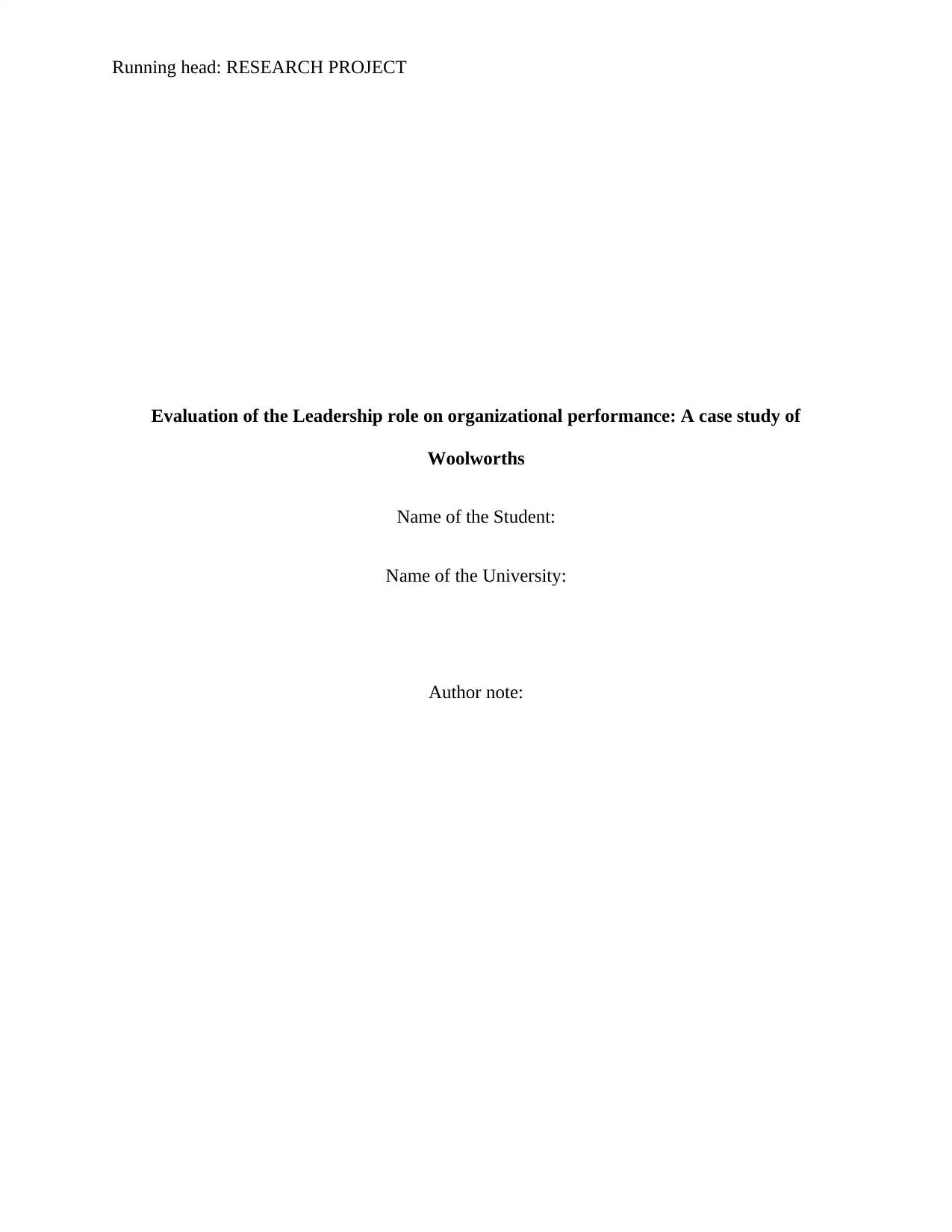
Running head: RESEARCH PROJECT
Evaluation of the Leadership role on organizational performance: A case study of
Woolworths
Name of the Student:
Name of the University:
Author note:
Evaluation of the Leadership role on organizational performance: A case study of
Woolworths
Name of the Student:
Name of the University:
Author note:
Paraphrase This Document
Need a fresh take? Get an instant paraphrase of this document with our AI Paraphraser
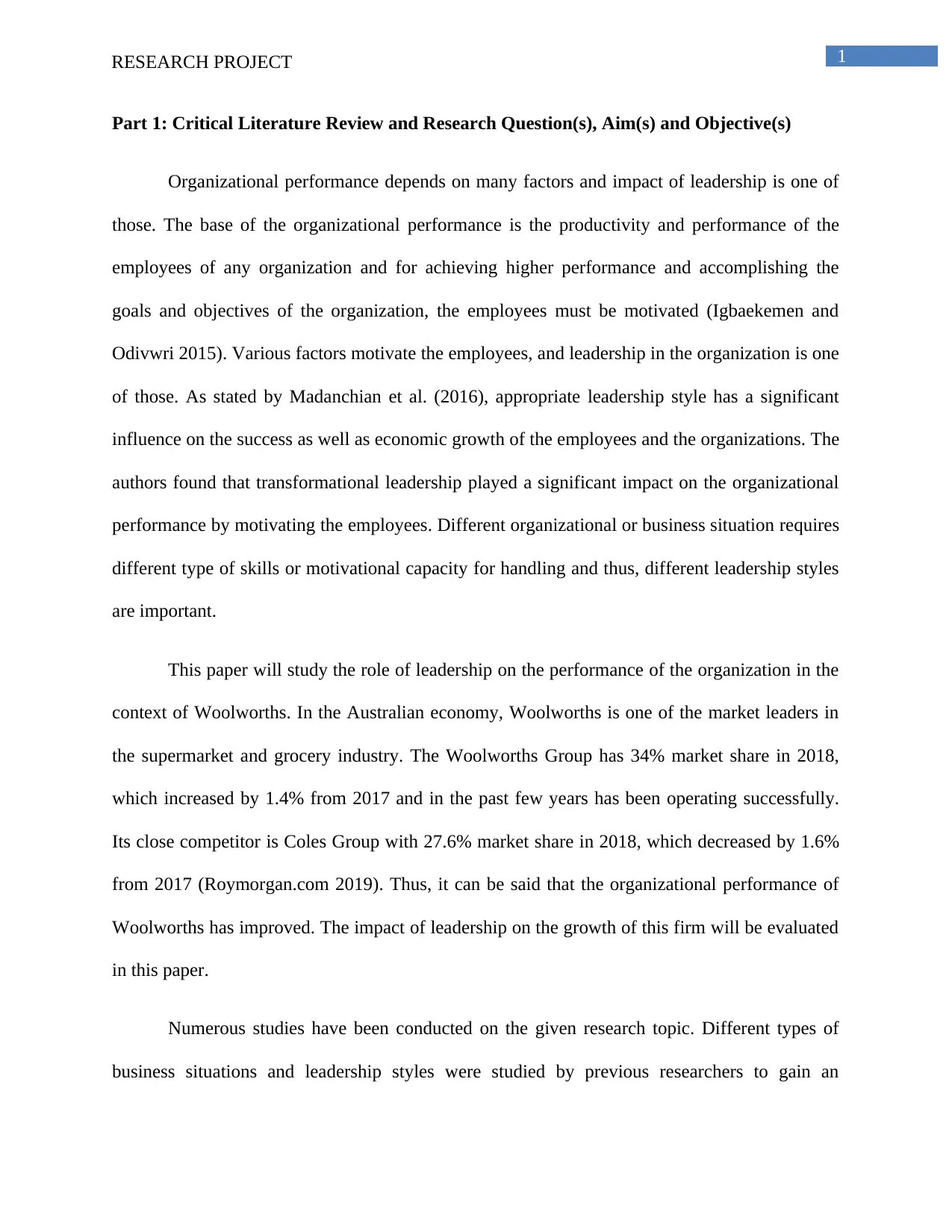
1RESEARCH PROJECT
Part 1: Critical Literature Review and Research Question(s), Aim(s) and Objective(s)
Organizational performance depends on many factors and impact of leadership is one of
those. The base of the organizational performance is the productivity and performance of the
employees of any organization and for achieving higher performance and accomplishing the
goals and objectives of the organization, the employees must be motivated (Igbaekemen and
Odivwri 2015). Various factors motivate the employees, and leadership in the organization is one
of those. As stated by Madanchian et al. (2016), appropriate leadership style has a significant
influence on the success as well as economic growth of the employees and the organizations. The
authors found that transformational leadership played a significant impact on the organizational
performance by motivating the employees. Different organizational or business situation requires
different type of skills or motivational capacity for handling and thus, different leadership styles
are important.
This paper will study the role of leadership on the performance of the organization in the
context of Woolworths. In the Australian economy, Woolworths is one of the market leaders in
the supermarket and grocery industry. The Woolworths Group has 34% market share in 2018,
which increased by 1.4% from 2017 and in the past few years has been operating successfully.
Its close competitor is Coles Group with 27.6% market share in 2018, which decreased by 1.6%
from 2017 (Roymorgan.com 2019). Thus, it can be said that the organizational performance of
Woolworths has improved. The impact of leadership on the growth of this firm will be evaluated
in this paper.
Numerous studies have been conducted on the given research topic. Different types of
business situations and leadership styles were studied by previous researchers to gain an
Part 1: Critical Literature Review and Research Question(s), Aim(s) and Objective(s)
Organizational performance depends on many factors and impact of leadership is one of
those. The base of the organizational performance is the productivity and performance of the
employees of any organization and for achieving higher performance and accomplishing the
goals and objectives of the organization, the employees must be motivated (Igbaekemen and
Odivwri 2015). Various factors motivate the employees, and leadership in the organization is one
of those. As stated by Madanchian et al. (2016), appropriate leadership style has a significant
influence on the success as well as economic growth of the employees and the organizations. The
authors found that transformational leadership played a significant impact on the organizational
performance by motivating the employees. Different organizational or business situation requires
different type of skills or motivational capacity for handling and thus, different leadership styles
are important.
This paper will study the role of leadership on the performance of the organization in the
context of Woolworths. In the Australian economy, Woolworths is one of the market leaders in
the supermarket and grocery industry. The Woolworths Group has 34% market share in 2018,
which increased by 1.4% from 2017 and in the past few years has been operating successfully.
Its close competitor is Coles Group with 27.6% market share in 2018, which decreased by 1.6%
from 2017 (Roymorgan.com 2019). Thus, it can be said that the organizational performance of
Woolworths has improved. The impact of leadership on the growth of this firm will be evaluated
in this paper.
Numerous studies have been conducted on the given research topic. Different types of
business situations and leadership styles were studied by previous researchers to gain an
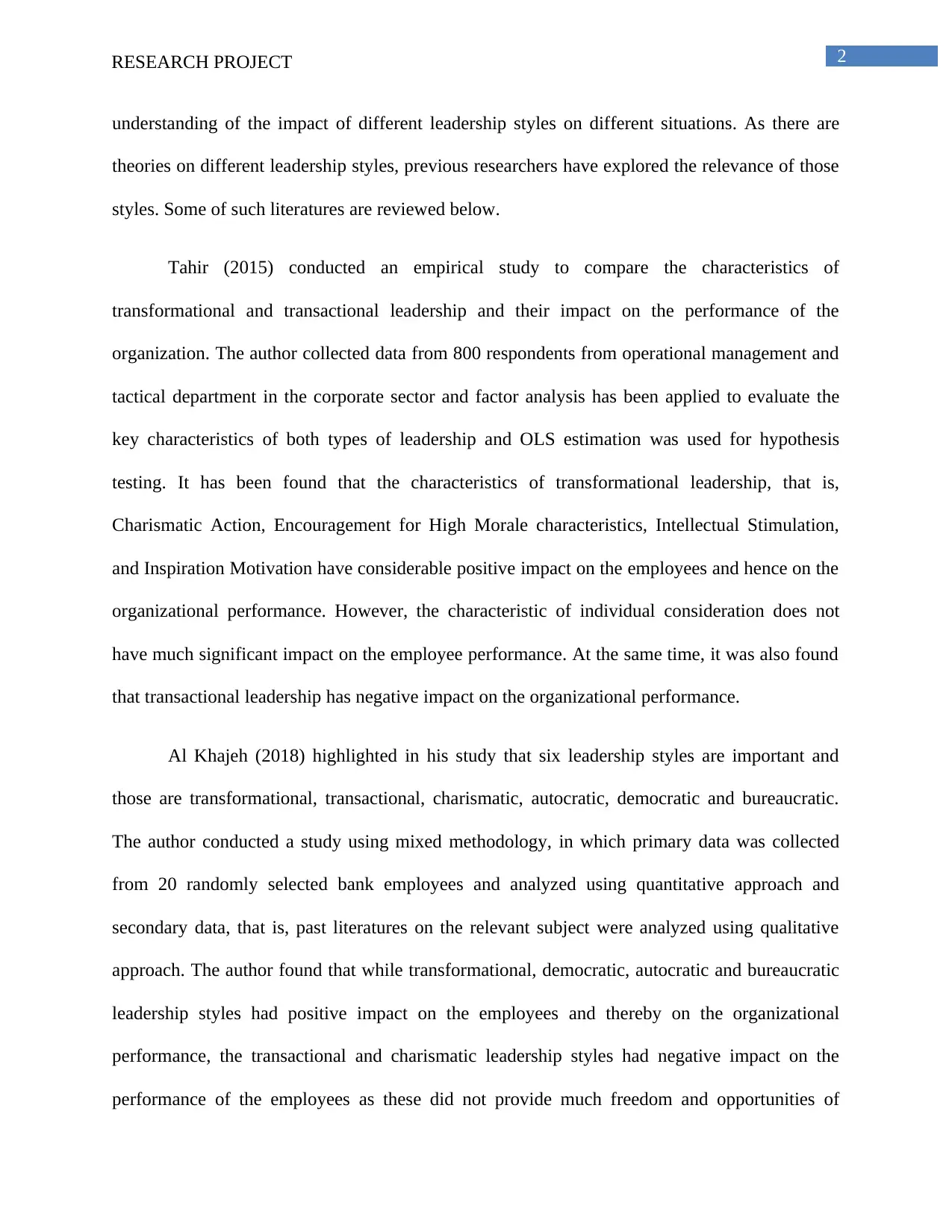
2RESEARCH PROJECT
understanding of the impact of different leadership styles on different situations. As there are
theories on different leadership styles, previous researchers have explored the relevance of those
styles. Some of such literatures are reviewed below.
Tahir (2015) conducted an empirical study to compare the characteristics of
transformational and transactional leadership and their impact on the performance of the
organization. The author collected data from 800 respondents from operational management and
tactical department in the corporate sector and factor analysis has been applied to evaluate the
key characteristics of both types of leadership and OLS estimation was used for hypothesis
testing. It has been found that the characteristics of transformational leadership, that is,
Charismatic Action, Encouragement for High Morale characteristics, Intellectual Stimulation,
and Inspiration Motivation have considerable positive impact on the employees and hence on the
organizational performance. However, the characteristic of individual consideration does not
have much significant impact on the employee performance. At the same time, it was also found
that transactional leadership has negative impact on the organizational performance.
Al Khajeh (2018) highlighted in his study that six leadership styles are important and
those are transformational, transactional, charismatic, autocratic, democratic and bureaucratic.
The author conducted a study using mixed methodology, in which primary data was collected
from 20 randomly selected bank employees and analyzed using quantitative approach and
secondary data, that is, past literatures on the relevant subject were analyzed using qualitative
approach. The author found that while transformational, democratic, autocratic and bureaucratic
leadership styles had positive impact on the employees and thereby on the organizational
performance, the transactional and charismatic leadership styles had negative impact on the
performance of the employees as these did not provide much freedom and opportunities of
understanding of the impact of different leadership styles on different situations. As there are
theories on different leadership styles, previous researchers have explored the relevance of those
styles. Some of such literatures are reviewed below.
Tahir (2015) conducted an empirical study to compare the characteristics of
transformational and transactional leadership and their impact on the performance of the
organization. The author collected data from 800 respondents from operational management and
tactical department in the corporate sector and factor analysis has been applied to evaluate the
key characteristics of both types of leadership and OLS estimation was used for hypothesis
testing. It has been found that the characteristics of transformational leadership, that is,
Charismatic Action, Encouragement for High Morale characteristics, Intellectual Stimulation,
and Inspiration Motivation have considerable positive impact on the employees and hence on the
organizational performance. However, the characteristic of individual consideration does not
have much significant impact on the employee performance. At the same time, it was also found
that transactional leadership has negative impact on the organizational performance.
Al Khajeh (2018) highlighted in his study that six leadership styles are important and
those are transformational, transactional, charismatic, autocratic, democratic and bureaucratic.
The author conducted a study using mixed methodology, in which primary data was collected
from 20 randomly selected bank employees and analyzed using quantitative approach and
secondary data, that is, past literatures on the relevant subject were analyzed using qualitative
approach. The author found that while transformational, democratic, autocratic and bureaucratic
leadership styles had positive impact on the employees and thereby on the organizational
performance, the transactional and charismatic leadership styles had negative impact on the
performance of the employees as these did not provide much freedom and opportunities of
⊘ This is a preview!⊘
Do you want full access?
Subscribe today to unlock all pages.

Trusted by 1+ million students worldwide
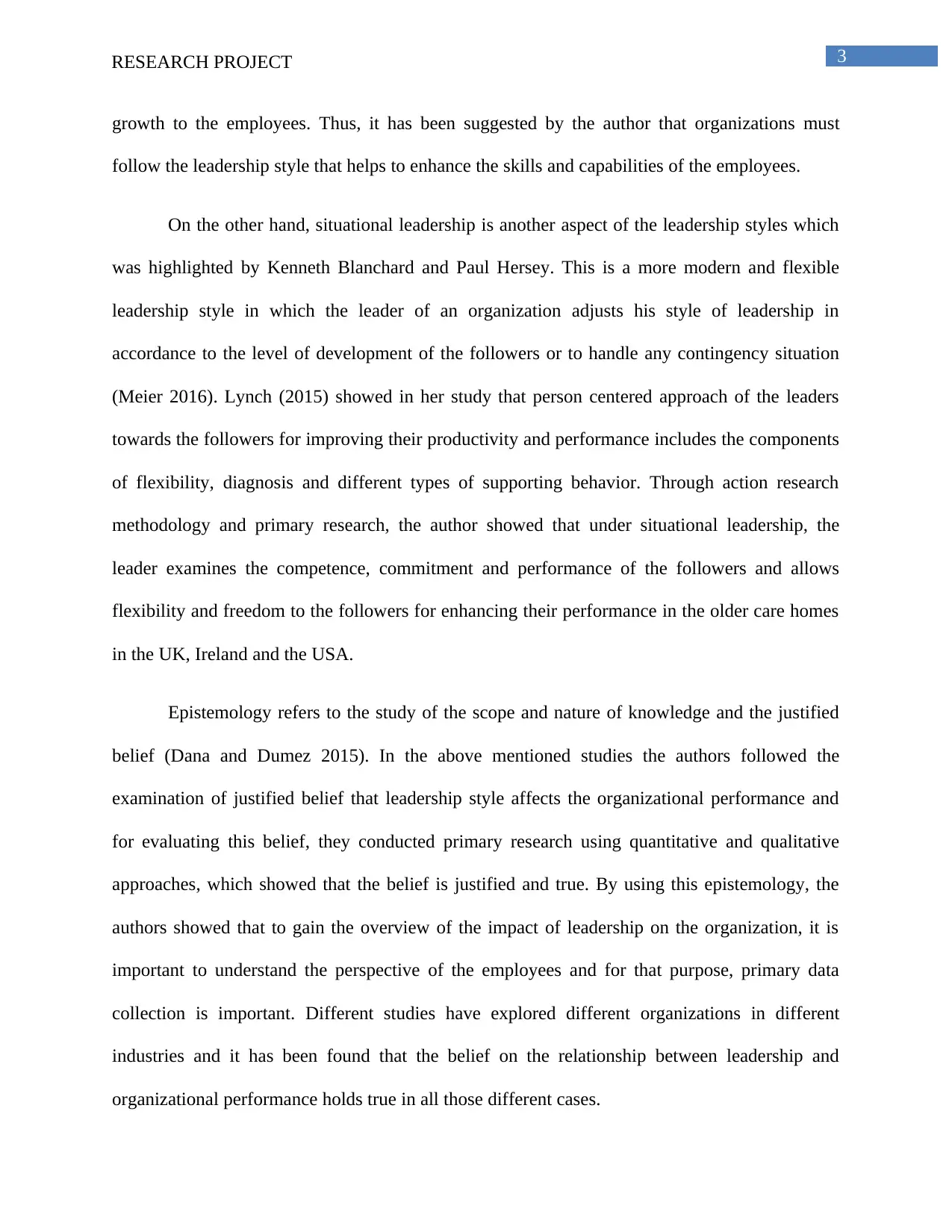
3RESEARCH PROJECT
growth to the employees. Thus, it has been suggested by the author that organizations must
follow the leadership style that helps to enhance the skills and capabilities of the employees.
On the other hand, situational leadership is another aspect of the leadership styles which
was highlighted by Kenneth Blanchard and Paul Hersey. This is a more modern and flexible
leadership style in which the leader of an organization adjusts his style of leadership in
accordance to the level of development of the followers or to handle any contingency situation
(Meier 2016). Lynch (2015) showed in her study that person centered approach of the leaders
towards the followers for improving their productivity and performance includes the components
of flexibility, diagnosis and different types of supporting behavior. Through action research
methodology and primary research, the author showed that under situational leadership, the
leader examines the competence, commitment and performance of the followers and allows
flexibility and freedom to the followers for enhancing their performance in the older care homes
in the UK, Ireland and the USA.
Epistemology refers to the study of the scope and nature of knowledge and the justified
belief (Dana and Dumez 2015). In the above mentioned studies the authors followed the
examination of justified belief that leadership style affects the organizational performance and
for evaluating this belief, they conducted primary research using quantitative and qualitative
approaches, which showed that the belief is justified and true. By using this epistemology, the
authors showed that to gain the overview of the impact of leadership on the organization, it is
important to understand the perspective of the employees and for that purpose, primary data
collection is important. Different studies have explored different organizations in different
industries and it has been found that the belief on the relationship between leadership and
organizational performance holds true in all those different cases.
growth to the employees. Thus, it has been suggested by the author that organizations must
follow the leadership style that helps to enhance the skills and capabilities of the employees.
On the other hand, situational leadership is another aspect of the leadership styles which
was highlighted by Kenneth Blanchard and Paul Hersey. This is a more modern and flexible
leadership style in which the leader of an organization adjusts his style of leadership in
accordance to the level of development of the followers or to handle any contingency situation
(Meier 2016). Lynch (2015) showed in her study that person centered approach of the leaders
towards the followers for improving their productivity and performance includes the components
of flexibility, diagnosis and different types of supporting behavior. Through action research
methodology and primary research, the author showed that under situational leadership, the
leader examines the competence, commitment and performance of the followers and allows
flexibility and freedom to the followers for enhancing their performance in the older care homes
in the UK, Ireland and the USA.
Epistemology refers to the study of the scope and nature of knowledge and the justified
belief (Dana and Dumez 2015). In the above mentioned studies the authors followed the
examination of justified belief that leadership style affects the organizational performance and
for evaluating this belief, they conducted primary research using quantitative and qualitative
approaches, which showed that the belief is justified and true. By using this epistemology, the
authors showed that to gain the overview of the impact of leadership on the organization, it is
important to understand the perspective of the employees and for that purpose, primary data
collection is important. Different studies have explored different organizations in different
industries and it has been found that the belief on the relationship between leadership and
organizational performance holds true in all those different cases.
Paraphrase This Document
Need a fresh take? Get an instant paraphrase of this document with our AI Paraphraser
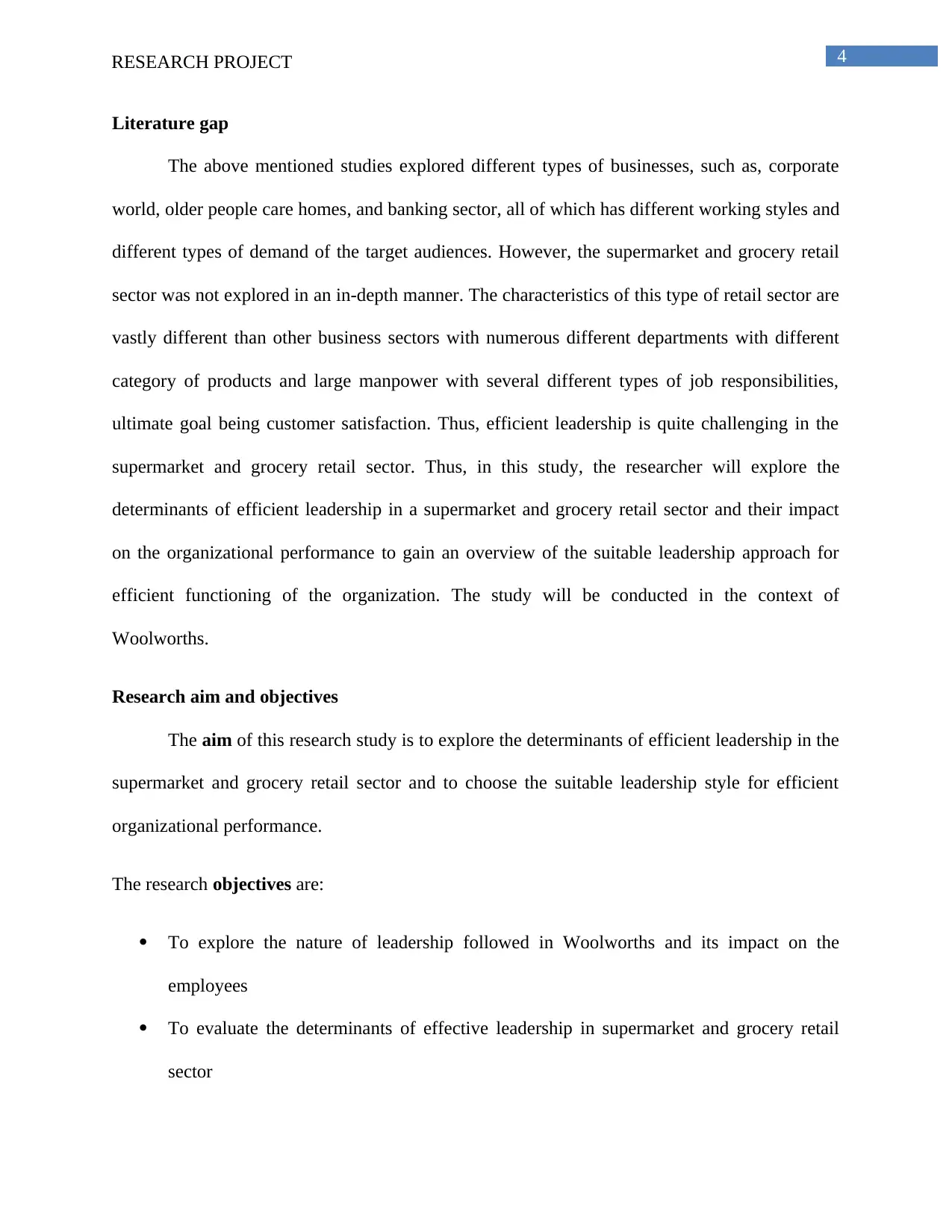
4RESEARCH PROJECT
Literature gap
The above mentioned studies explored different types of businesses, such as, corporate
world, older people care homes, and banking sector, all of which has different working styles and
different types of demand of the target audiences. However, the supermarket and grocery retail
sector was not explored in an in-depth manner. The characteristics of this type of retail sector are
vastly different than other business sectors with numerous different departments with different
category of products and large manpower with several different types of job responsibilities,
ultimate goal being customer satisfaction. Thus, efficient leadership is quite challenging in the
supermarket and grocery retail sector. Thus, in this study, the researcher will explore the
determinants of efficient leadership in a supermarket and grocery retail sector and their impact
on the organizational performance to gain an overview of the suitable leadership approach for
efficient functioning of the organization. The study will be conducted in the context of
Woolworths.
Research aim and objectives
The aim of this research study is to explore the determinants of efficient leadership in the
supermarket and grocery retail sector and to choose the suitable leadership style for efficient
organizational performance.
The research objectives are:
To explore the nature of leadership followed in Woolworths and its impact on the
employees
To evaluate the determinants of effective leadership in supermarket and grocery retail
sector
Literature gap
The above mentioned studies explored different types of businesses, such as, corporate
world, older people care homes, and banking sector, all of which has different working styles and
different types of demand of the target audiences. However, the supermarket and grocery retail
sector was not explored in an in-depth manner. The characteristics of this type of retail sector are
vastly different than other business sectors with numerous different departments with different
category of products and large manpower with several different types of job responsibilities,
ultimate goal being customer satisfaction. Thus, efficient leadership is quite challenging in the
supermarket and grocery retail sector. Thus, in this study, the researcher will explore the
determinants of efficient leadership in a supermarket and grocery retail sector and their impact
on the organizational performance to gain an overview of the suitable leadership approach for
efficient functioning of the organization. The study will be conducted in the context of
Woolworths.
Research aim and objectives
The aim of this research study is to explore the determinants of efficient leadership in the
supermarket and grocery retail sector and to choose the suitable leadership style for efficient
organizational performance.
The research objectives are:
To explore the nature of leadership followed in Woolworths and its impact on the
employees
To evaluate the determinants of effective leadership in supermarket and grocery retail
sector
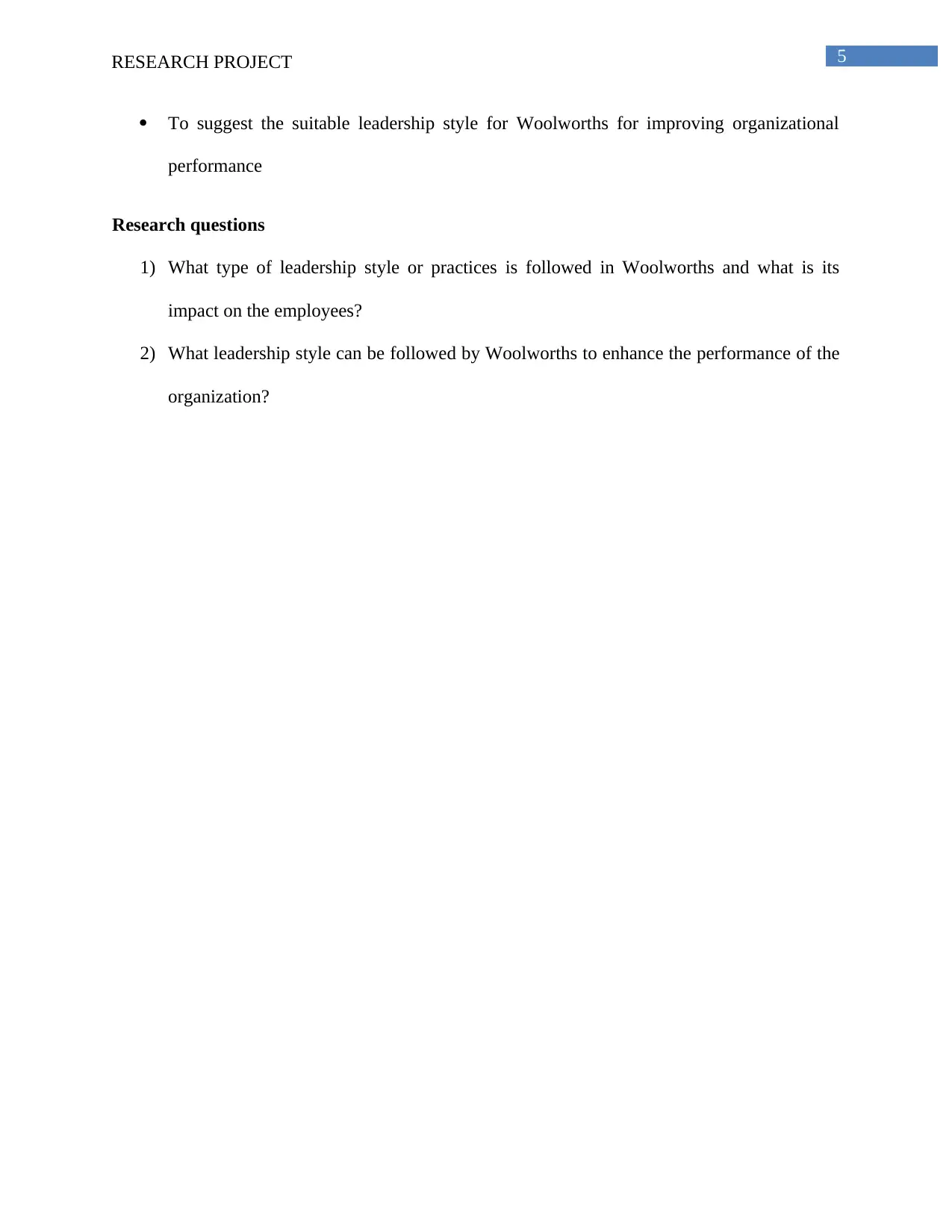
5RESEARCH PROJECT
To suggest the suitable leadership style for Woolworths for improving organizational
performance
Research questions
1) What type of leadership style or practices is followed in Woolworths and what is its
impact on the employees?
2) What leadership style can be followed by Woolworths to enhance the performance of the
organization?
To suggest the suitable leadership style for Woolworths for improving organizational
performance
Research questions
1) What type of leadership style or practices is followed in Woolworths and what is its
impact on the employees?
2) What leadership style can be followed by Woolworths to enhance the performance of the
organization?
⊘ This is a preview!⊘
Do you want full access?
Subscribe today to unlock all pages.

Trusted by 1+ million students worldwide
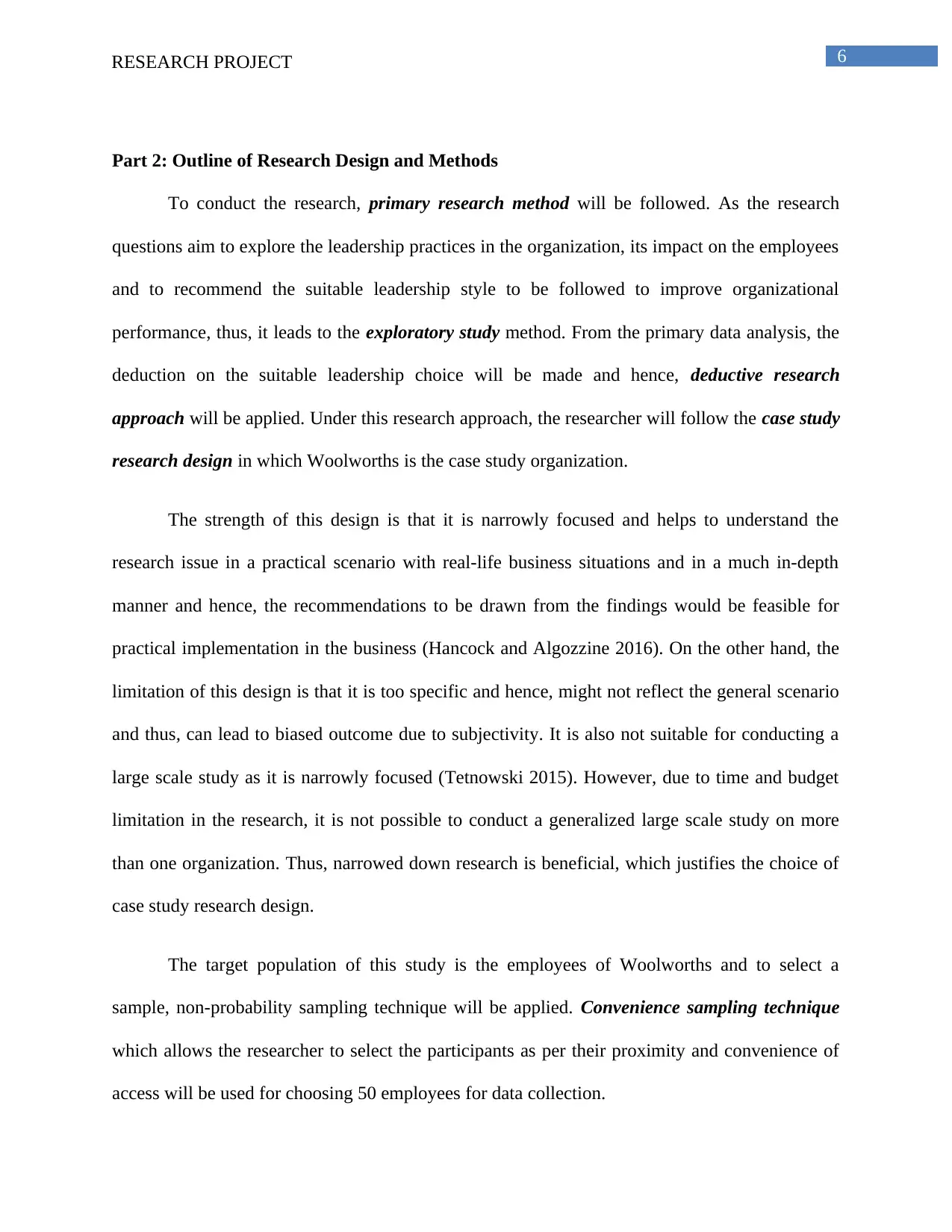
6RESEARCH PROJECT
Part 2: Outline of Research Design and Methods
To conduct the research, primary research method will be followed. As the research
questions aim to explore the leadership practices in the organization, its impact on the employees
and to recommend the suitable leadership style to be followed to improve organizational
performance, thus, it leads to the exploratory study method. From the primary data analysis, the
deduction on the suitable leadership choice will be made and hence, deductive research
approach will be applied. Under this research approach, the researcher will follow the case study
research design in which Woolworths is the case study organization.
The strength of this design is that it is narrowly focused and helps to understand the
research issue in a practical scenario with real-life business situations and in a much in-depth
manner and hence, the recommendations to be drawn from the findings would be feasible for
practical implementation in the business (Hancock and Algozzine 2016). On the other hand, the
limitation of this design is that it is too specific and hence, might not reflect the general scenario
and thus, can lead to biased outcome due to subjectivity. It is also not suitable for conducting a
large scale study as it is narrowly focused (Tetnowski 2015). However, due to time and budget
limitation in the research, it is not possible to conduct a generalized large scale study on more
than one organization. Thus, narrowed down research is beneficial, which justifies the choice of
case study research design.
The target population of this study is the employees of Woolworths and to select a
sample, non-probability sampling technique will be applied. Convenience sampling technique
which allows the researcher to select the participants as per their proximity and convenience of
access will be used for choosing 50 employees for data collection.
Part 2: Outline of Research Design and Methods
To conduct the research, primary research method will be followed. As the research
questions aim to explore the leadership practices in the organization, its impact on the employees
and to recommend the suitable leadership style to be followed to improve organizational
performance, thus, it leads to the exploratory study method. From the primary data analysis, the
deduction on the suitable leadership choice will be made and hence, deductive research
approach will be applied. Under this research approach, the researcher will follow the case study
research design in which Woolworths is the case study organization.
The strength of this design is that it is narrowly focused and helps to understand the
research issue in a practical scenario with real-life business situations and in a much in-depth
manner and hence, the recommendations to be drawn from the findings would be feasible for
practical implementation in the business (Hancock and Algozzine 2016). On the other hand, the
limitation of this design is that it is too specific and hence, might not reflect the general scenario
and thus, can lead to biased outcome due to subjectivity. It is also not suitable for conducting a
large scale study as it is narrowly focused (Tetnowski 2015). However, due to time and budget
limitation in the research, it is not possible to conduct a generalized large scale study on more
than one organization. Thus, narrowed down research is beneficial, which justifies the choice of
case study research design.
The target population of this study is the employees of Woolworths and to select a
sample, non-probability sampling technique will be applied. Convenience sampling technique
which allows the researcher to select the participants as per their proximity and convenience of
access will be used for choosing 50 employees for data collection.
Paraphrase This Document
Need a fresh take? Get an instant paraphrase of this document with our AI Paraphraser
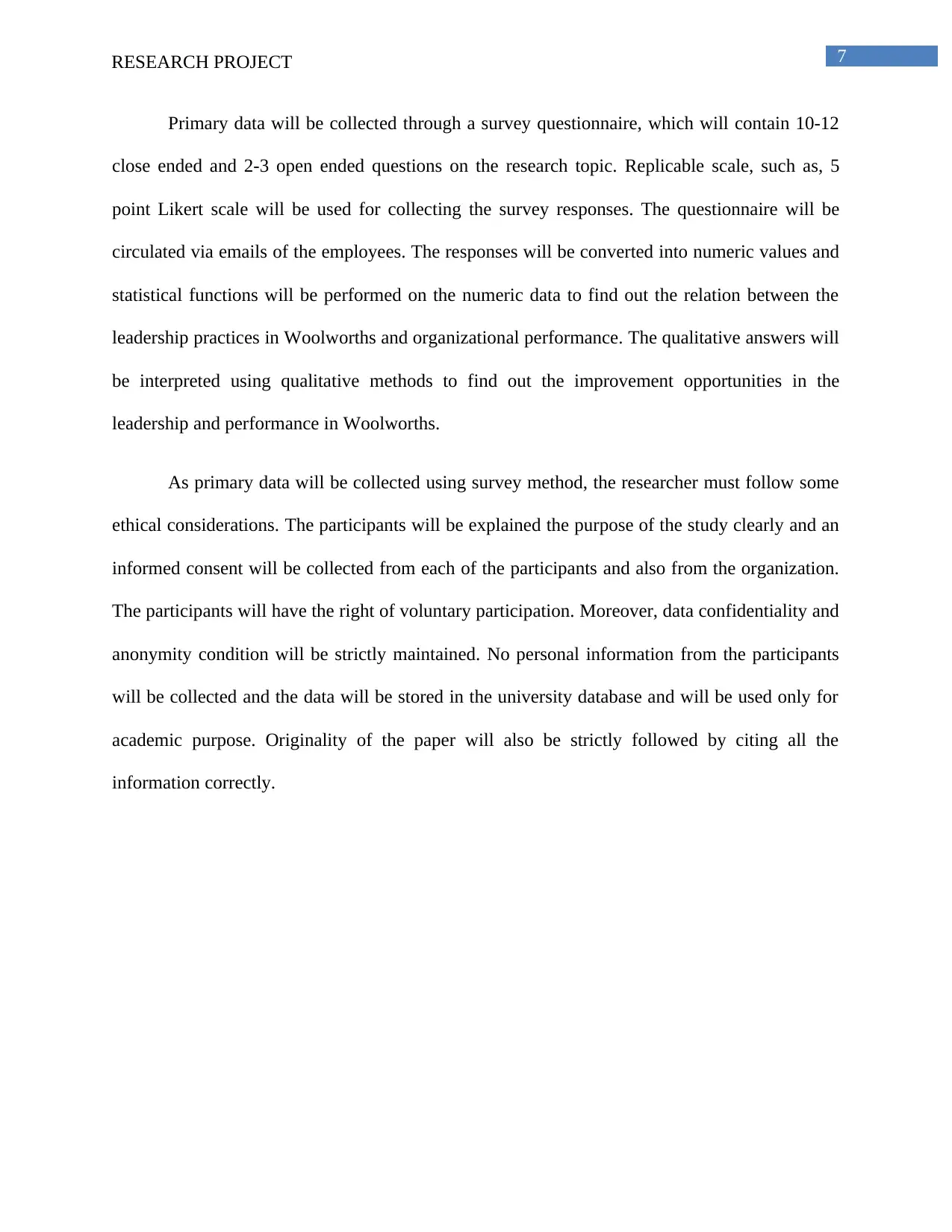
7RESEARCH PROJECT
Primary data will be collected through a survey questionnaire, which will contain 10-12
close ended and 2-3 open ended questions on the research topic. Replicable scale, such as, 5
point Likert scale will be used for collecting the survey responses. The questionnaire will be
circulated via emails of the employees. The responses will be converted into numeric values and
statistical functions will be performed on the numeric data to find out the relation between the
leadership practices in Woolworths and organizational performance. The qualitative answers will
be interpreted using qualitative methods to find out the improvement opportunities in the
leadership and performance in Woolworths.
As primary data will be collected using survey method, the researcher must follow some
ethical considerations. The participants will be explained the purpose of the study clearly and an
informed consent will be collected from each of the participants and also from the organization.
The participants will have the right of voluntary participation. Moreover, data confidentiality and
anonymity condition will be strictly maintained. No personal information from the participants
will be collected and the data will be stored in the university database and will be used only for
academic purpose. Originality of the paper will also be strictly followed by citing all the
information correctly.
Primary data will be collected through a survey questionnaire, which will contain 10-12
close ended and 2-3 open ended questions on the research topic. Replicable scale, such as, 5
point Likert scale will be used for collecting the survey responses. The questionnaire will be
circulated via emails of the employees. The responses will be converted into numeric values and
statistical functions will be performed on the numeric data to find out the relation between the
leadership practices in Woolworths and organizational performance. The qualitative answers will
be interpreted using qualitative methods to find out the improvement opportunities in the
leadership and performance in Woolworths.
As primary data will be collected using survey method, the researcher must follow some
ethical considerations. The participants will be explained the purpose of the study clearly and an
informed consent will be collected from each of the participants and also from the organization.
The participants will have the right of voluntary participation. Moreover, data confidentiality and
anonymity condition will be strictly maintained. No personal information from the participants
will be collected and the data will be stored in the university database and will be used only for
academic purpose. Originality of the paper will also be strictly followed by citing all the
information correctly.
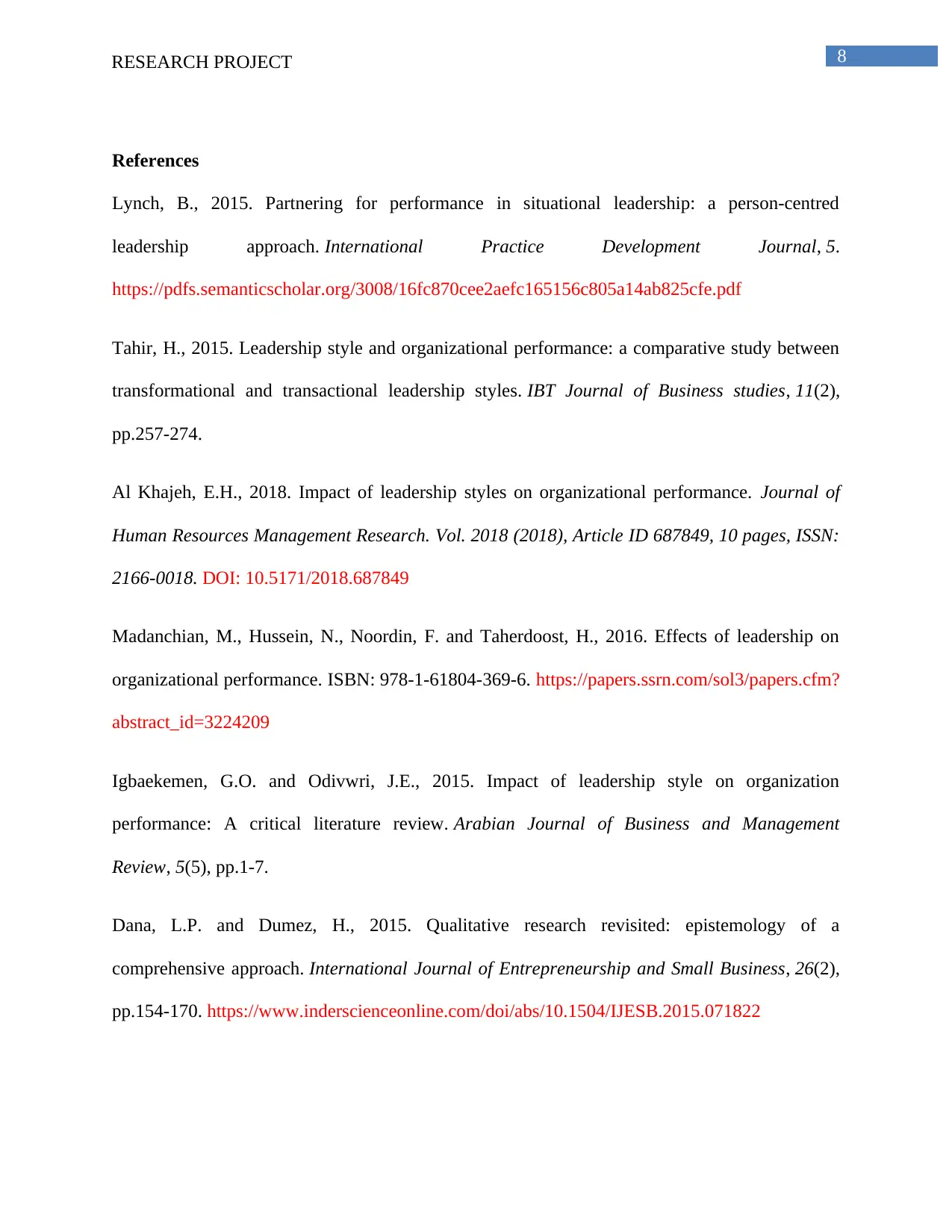
8RESEARCH PROJECT
References
Lynch, B., 2015. Partnering for performance in situational leadership: a person-centred
leadership approach. International Practice Development Journal, 5.
https://pdfs.semanticscholar.org/3008/16fc870cee2aefc165156c805a14ab825cfe.pdf
Tahir, H., 2015. Leadership style and organizational performance: a comparative study between
transformational and transactional leadership styles. IBT Journal of Business studies, 11(2),
pp.257-274.
Al Khajeh, E.H., 2018. Impact of leadership styles on organizational performance. Journal of
Human Resources Management Research. Vol. 2018 (2018), Article ID 687849, 10 pages, ISSN:
2166-0018. DOI: 10.5171/2018.687849
Madanchian, M., Hussein, N., Noordin, F. and Taherdoost, H., 2016. Effects of leadership on
organizational performance. ISBN: 978-1-61804-369-6. https://papers.ssrn.com/sol3/papers.cfm?
abstract_id=3224209
Igbaekemen, G.O. and Odivwri, J.E., 2015. Impact of leadership style on organization
performance: A critical literature review. Arabian Journal of Business and Management
Review, 5(5), pp.1-7.
Dana, L.P. and Dumez, H., 2015. Qualitative research revisited: epistemology of a
comprehensive approach. International Journal of Entrepreneurship and Small Business, 26(2),
pp.154-170. https://www.inderscienceonline.com/doi/abs/10.1504/IJESB.2015.071822
References
Lynch, B., 2015. Partnering for performance in situational leadership: a person-centred
leadership approach. International Practice Development Journal, 5.
https://pdfs.semanticscholar.org/3008/16fc870cee2aefc165156c805a14ab825cfe.pdf
Tahir, H., 2015. Leadership style and organizational performance: a comparative study between
transformational and transactional leadership styles. IBT Journal of Business studies, 11(2),
pp.257-274.
Al Khajeh, E.H., 2018. Impact of leadership styles on organizational performance. Journal of
Human Resources Management Research. Vol. 2018 (2018), Article ID 687849, 10 pages, ISSN:
2166-0018. DOI: 10.5171/2018.687849
Madanchian, M., Hussein, N., Noordin, F. and Taherdoost, H., 2016. Effects of leadership on
organizational performance. ISBN: 978-1-61804-369-6. https://papers.ssrn.com/sol3/papers.cfm?
abstract_id=3224209
Igbaekemen, G.O. and Odivwri, J.E., 2015. Impact of leadership style on organization
performance: A critical literature review. Arabian Journal of Business and Management
Review, 5(5), pp.1-7.
Dana, L.P. and Dumez, H., 2015. Qualitative research revisited: epistemology of a
comprehensive approach. International Journal of Entrepreneurship and Small Business, 26(2),
pp.154-170. https://www.inderscienceonline.com/doi/abs/10.1504/IJESB.2015.071822
⊘ This is a preview!⊘
Do you want full access?
Subscribe today to unlock all pages.

Trusted by 1+ million students worldwide
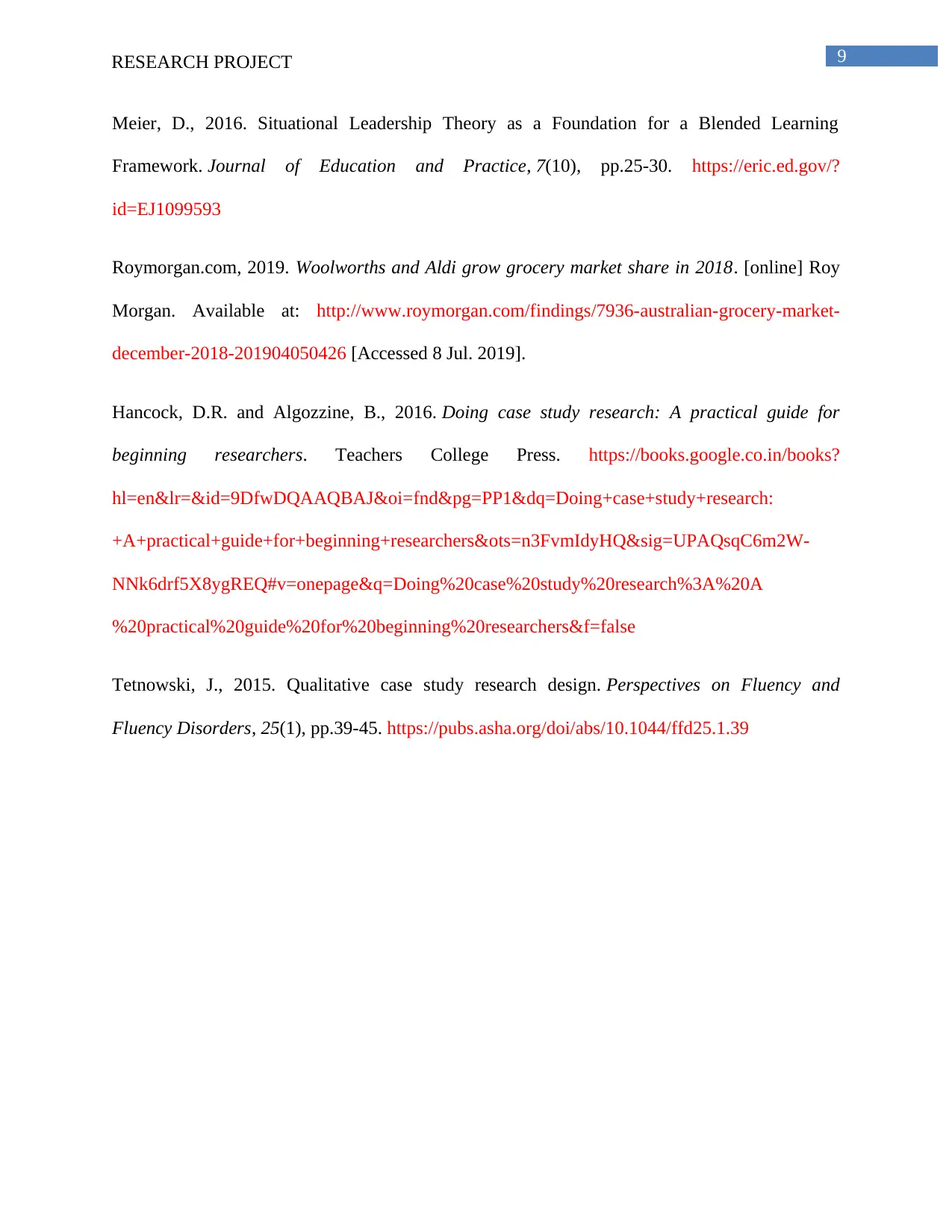
9RESEARCH PROJECT
Meier, D., 2016. Situational Leadership Theory as a Foundation for a Blended Learning
Framework. Journal of Education and Practice, 7(10), pp.25-30. https://eric.ed.gov/?
id=EJ1099593
Roymorgan.com, 2019. Woolworths and Aldi grow grocery market share in 2018. [online] Roy
Morgan. Available at: http://www.roymorgan.com/findings/7936-australian-grocery-market-
december-2018-201904050426 [Accessed 8 Jul. 2019].
Hancock, D.R. and Algozzine, B., 2016. Doing case study research: A practical guide for
beginning researchers. Teachers College Press. https://books.google.co.in/books?
hl=en&lr=&id=9DfwDQAAQBAJ&oi=fnd&pg=PP1&dq=Doing+case+study+research:
+A+practical+guide+for+beginning+researchers&ots=n3FvmIdyHQ&sig=UPAQsqC6m2W-
NNk6drf5X8ygREQ#v=onepage&q=Doing%20case%20study%20research%3A%20A
%20practical%20guide%20for%20beginning%20researchers&f=false
Tetnowski, J., 2015. Qualitative case study research design. Perspectives on Fluency and
Fluency Disorders, 25(1), pp.39-45. https://pubs.asha.org/doi/abs/10.1044/ffd25.1.39
Meier, D., 2016. Situational Leadership Theory as a Foundation for a Blended Learning
Framework. Journal of Education and Practice, 7(10), pp.25-30. https://eric.ed.gov/?
id=EJ1099593
Roymorgan.com, 2019. Woolworths and Aldi grow grocery market share in 2018. [online] Roy
Morgan. Available at: http://www.roymorgan.com/findings/7936-australian-grocery-market-
december-2018-201904050426 [Accessed 8 Jul. 2019].
Hancock, D.R. and Algozzine, B., 2016. Doing case study research: A practical guide for
beginning researchers. Teachers College Press. https://books.google.co.in/books?
hl=en&lr=&id=9DfwDQAAQBAJ&oi=fnd&pg=PP1&dq=Doing+case+study+research:
+A+practical+guide+for+beginning+researchers&ots=n3FvmIdyHQ&sig=UPAQsqC6m2W-
NNk6drf5X8ygREQ#v=onepage&q=Doing%20case%20study%20research%3A%20A
%20practical%20guide%20for%20beginning%20researchers&f=false
Tetnowski, J., 2015. Qualitative case study research design. Perspectives on Fluency and
Fluency Disorders, 25(1), pp.39-45. https://pubs.asha.org/doi/abs/10.1044/ffd25.1.39
1 out of 10
Related Documents
Your All-in-One AI-Powered Toolkit for Academic Success.
+13062052269
info@desklib.com
Available 24*7 on WhatsApp / Email
![[object Object]](/_next/static/media/star-bottom.7253800d.svg)
Unlock your academic potential
Copyright © 2020–2025 A2Z Services. All Rights Reserved. Developed and managed by ZUCOL.





